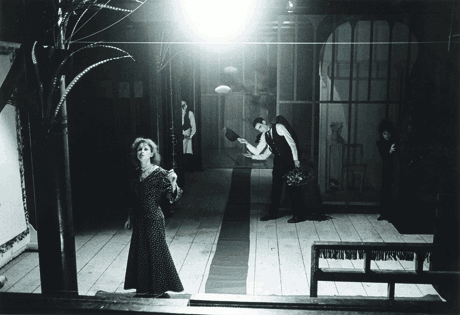| TOUCHING III with COLLAGE III
This version will be the third one of the series TOUCHING and like the preceding versions will entice the viewer/ participant to explore through manipulation of prints and contact sheets some of the choices that a photographer experiences to select which photos to print and print sizes to try out.
Touch III Slide Show:

In this new version of TOUCHING, the prints displayed on the table have been selected from my archives of theater photographs that are quite different from my dance and performance photos. In theater the actor’s gaze is of great importance and often it is the deciding factor in the taking of the photograph. The sets are rarely flat backdrop so the dynamic between figures and space is depending for effect and meaning on a built-in architecture set on the stage that is movable from scene to scene. Most actions oppose a group of performers to another, so each images can be linked through narrative tissue unlike photos of dance and performance.
The multiples prints on the table share similarities even it there are of very different theater productions and it is the subtle details in the variations that the viewer/player discover while manipulating and sorting out the prints that become the point for each table display. The focus for both tables is on Richard Foreman’s Ontologic-Hysteric Theater, and the performance work of one of his performer Stuart Sherman for table 1 and portraits of Foreman’s performers for table 2.
Foreman all through the 1970s worked with the same company of performers including Kate Mannheim his leading lady, establishing common threads among the numerous plays. Another characteristics of Foreman’s theater are the lights sources pointing straight into the audience eyes. The flares that are created by the lights reflecting inside my camera lens are creating a magical shift in some photographs. Another Foreman’s trademark is his set design that opposes flatness and extreme depth of the staging area. Invention in costumes and multiples props will add another source of fascination when comparing those images side by side on the table.
Near the tables a showing of COLLAGE III will provide the context for the times and the city when the photographs were taken. The film collage will be shown on an old television set and shows various New York City streets and buildings from New York Downtown, below 14th Street, which in the 1970s was mostly empty of pedestrians with blank facades and no traffic. The sound in particular in its sparseness is totally from the past.
The tables for display are of the same size and should not be too big so one person from one side can grab a print that is placed across the width of the table, which is positioned in the middle of the gallery space so several people can walk around the tables and play with the prints at the same time.
As in past installation, a selection of framed exhibition prints of some of the most spectacular photographs will be exposed in the proximity of the two-table display. With this simple juxtaposition, two approaches to what is photography are suddenly made visible.
Collage III Slide Show:

|